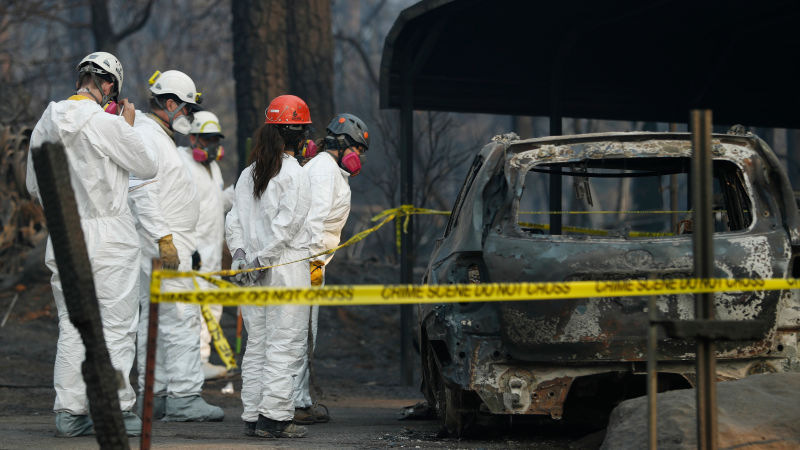
The confirmed death toll in the Camp Fire, the deadliest and most destructive fire in California history, has risen to 76, with nearly 1,300 names still remaining on an ad hoc list of missing individuals. The town of Paradise, which a firestorm overtook in a matter of hours on Nov. 8, is more or less totally destroyed.
According to a report in the Los Angeles Times, one question after the disaster is whether officials did enough to prepare for the eventuality of one of the state’s rampaging wildfires sweeping through the town. Paradise officials had seen one prior fire result in “disaster” a decade ago, the Times wrote, after a fire stopped at the edge of Paradise and “three of the four major roads out” of the region were ablaze. The result was hours of gridlock, leaving evacuees “defenseless” on the road and leading to many trying to outrun the fires on foot:
A grand jury report and county fire plans said Paradise needed a way to get everyone out quickly at once. Instead, Paradise leaders divided the town into evacuation zones that could be emptied a few at a time.
Following the lead of other fire-prone counties, Butte County contracted for a private warning system to alert residents in danger—if they had the foresight to sign up. The Paradise emergency operations director estimated no more than 30% of citizens were on the list.
Advertisement
According to the grand jury report, the Weather Channel wrote, many vehicles carrying evacuees had an effective speed of four miles per hour.
The new system didn’t work out that much better as the Camp Fire approached Paradise this month. While firefighters issued an evacuation order at 7:46 a.m. local time, that order only applied to the eastern zone of the town, the Times wrote. By the time they issued a general evacuation order applying to the remaining residents almost an hour later, the paper added, the situation had ended up much like the prior fire:
The result was that as the Camp fire entered Paradise, the evacuation order issued at 7:46 a.m. covered only the eastern quarter of town. Evacuation orders weren’t given to the rest of the city for nearly an hour.
Within two minutes of the broader warning, the first major traffic jam was reported. Then the evacuation corridors caught fire, as they had a decade before.
Advertisement
According to the Times, the main four-lane road for Paradise, the Skylane Boulevard, was designed for 1,200 cars per hour during rush hour, while almost 27,000 residents were subject to the evacuation order. The ensuing chaos saw people fleeing stalled cars on roads—one survivor told the paper her steering wheel began to melt—or simply ending up trapped, with emergency services overwhelmed and officers allegedly telling evacuees to commandeer any available vehicles.
“The problem in Paradise is that you can’t get out,” NPR reporter Paige St. John explained. “…Once they needed to move and you had an entire town that needed to get out all at once, the roads quickly turned into parking lots.”
36-year-old survivor Eric Smith, standing outside the charred rubble of his childhood home, told the Daily Beast, “It looks like a bomb went off. My childhood has burnt down.”
Advertisement
“How could they have organized it?” Smith added. “The fire was burning 80 football fields a minute. There’s one way in and out of here. I don’t know how anyone could have organized anything.”
A Cal Fire worker told the Beast that many individuals “died in their cars.” Butte County Sheriff Kory Honea added that the evacuation was “as orderly as could be under such a very, very frightening situation” and that emergency personnel were able to “save tens of thousands of lives.”
However, per the Mercury News, the sheriff’s department has conceded that they could have alerted more residents to the danger. Many reported receiving news of the evacuation too late, or not at all, due to an opt-in emergency warning system and a complicated protocol for carrying it out that moved slower than the spreading flames.
Advertisement
“It got to point where this thing was outrunning us before we even knew we were in race… by that time we started trying to message and get that information out there,” Honea told the paper. The Mercury News reported:
Others also said they didn’t get messages from the county’s Red Alert program Thursday. No news was delivered over the Amber Alert wireless emergency notification system, or through Nixle, they said. There was nothing on local radio. Television did not interrupt programming with an ‘emergency broadcast system’ warning. There were no sirens.
On Facebook, Cal Fire’s first post was at 10:07 a.m, and it was general, describing acreage and saying “Multiple evacuation orders have been issued.”
“We didn’t get a robo call, announcement or any notice from Cal Fire or city, We had to find out about it second-hand,” said Ethan Silverman.
“Neighbors – they came up and down the road telling us to leave,” said Gabriel Wilcox.
Advertisement
Mayor Jody Jones pointed towards the decision of many residents not to opt into the emergency alert system, telling the Mercury News: “There isn’t a town anywhere that could build the infrastructure so you would not have gridlock when you are evacuating everyone all at once. Had we not had that plan, had we not practiced the plan, we would have lost so many more lives.”
[L.A. Times]













